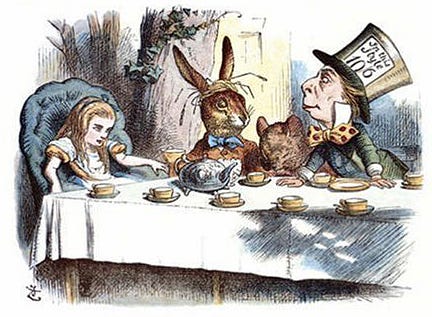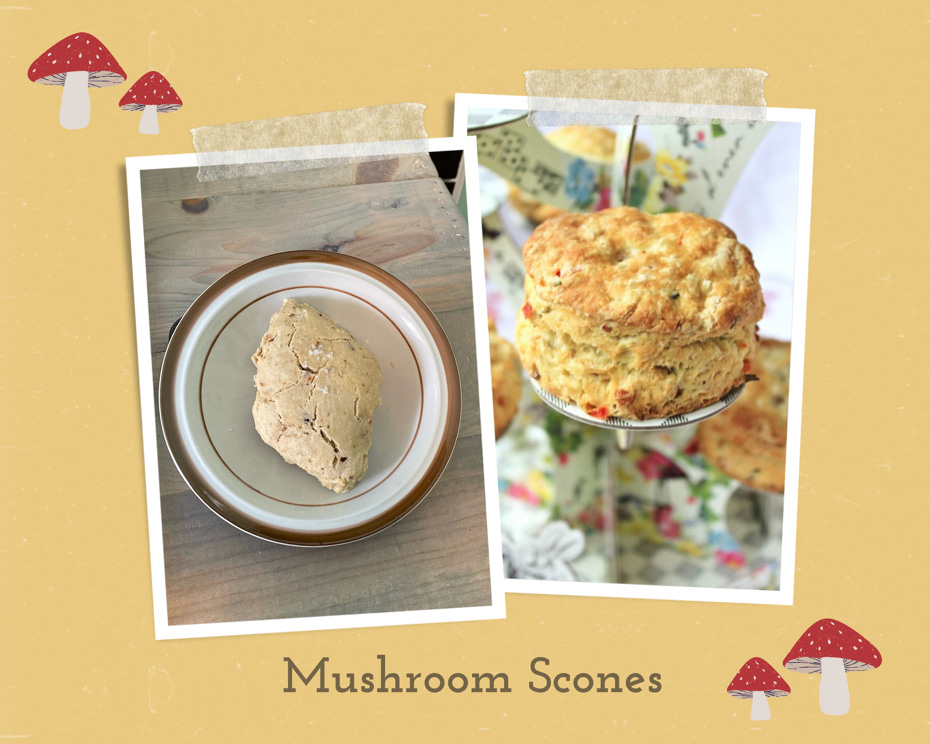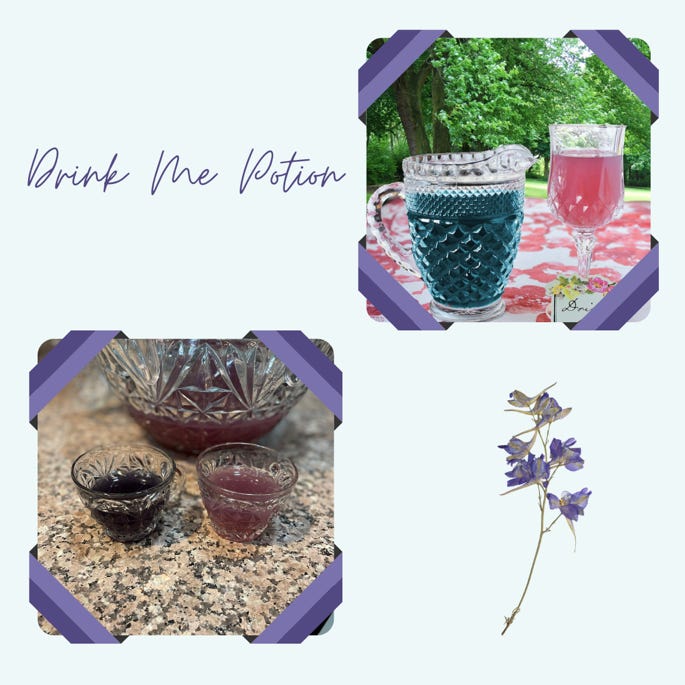A very merry unbirthday to Missing Pieces which celebrates its second anniversary this month! In case you missed them, check out this year’s top three articles below:
2. “Meet Me at the Brazilian Coffeehouse”
3. Birdwatching would not be Birdwatching without Theodore Roosevelt
To ring in the third year of Missing Pieces, I’m debuting new colors and a new logo, designed by my ever so talented husband, Cole Lane.
The new logo more accurately illustrates the focus of Missing Pieces: highlighting stories about Theodore Roosevelt and his world. And the new colors are inspired by a picture of Pine Knot, Theodore Roosevelt’s presidential retreat in Virginia.
To commemorate the second anniversary of Missing Pieces, I decided to celebrate by looking at two children’s books well-known in the GAPE: Alice’s Adventures in Wonderland and Through the Looking-Glass, and What Alice Found There. By 1900, these two volumes—collectively known as Alice—had become the most popular children’s book in England.
Source: Illustration by John Tenniel, Alice in Wonderland. Wikimedia Commons.
“[John] Tenniel’s tea party has had a profound influence on political cartoonists ever since Alice was first published; [Lewis] Carroll’s riddle-filled language and uncanny world attract those wishing to place contemporary events in a land where they may make more sense.” ~caption from “Politics in Wonderland,” Special Collections and Archives, University of Kent
And what better way to celebrate than with food? So, in addition to some stories from history, I’ll also be giving some food recommendations in this issue of Missing Pieces, taken from recipes in Alison Walsh’s new cookbook, A Literary Picnic. Walsh, a book and food lover, believes, “Food and books are best enjoyed together.” I wholeheartedly agree—and think TR would too!
Walsh has written several cookbooks, including A Literary Tea Party and A Literary Picnic, which both feature some Wonderland recipes. I opted to try three of the five Wonderland recipes from A Literary Picnic (available on Kindle and PDF). There’s even a fun printable menu (see below) for all five Wonderland recipes.
Source: Illustration courtesy of Alison Walsh
To have a larger audience trying these delicious delicacies, I decided to make the three recipes for my Wednesday night Bible study. A big thanks to Cole, Grace, Kaleb, Katie, Jeremy, Jonny, and Rini for being my taste testing team!
But before we get into the stories and the recipes, let’s talk about Alice and its influence on culture in the Gilded Age and Progressive Era, including on Theodore Roosevelt and his family.
The Roosevelts and Wonderland
We know that Theodore Roosevelt and his family were familiar with the Alice books and likely read them. TR was an avid reader, reading a book a day on average.
In a response to a request from children’s librarian Katherine Williams Watson in 1930, Edith Roosevelt reviewed a list of books and marked her favorites, including Alice’s Adventures in Wonderland and Through the Looking-Glass.
References to the Alice books also appeared regularly in popular culture, such as political cartoons like “The Free Silver Jabberwock,” which appeared in Puck magazine in 1896.
I had the opportunity to speak with librarian and archivist Joanna Baines of the University College London, who co-curated an exhibition in 2020 for the University of Kent entitled “Politics in Wonderland: Sir John Tenniel at 200,” about researching how frequently Alice was referenced in political cartoons available in the British Cartoon Archive.
“What struck me was how wide-reaching Carroll’s stories affect as metaphor. Wonderland itself frequently acts as a fantasy-lite touchpoint for political stories, implying that worlds or ideas are so similar to ours and yet so vastly removed. The characters from Carroll’s stories also appear very often in cartooning, whether that's through the Mad Hatter and his Tea Party (particularly relevant for American politics), the self-defeating logic of the twins Tweedledee and Tweedledum or Alice representing the straightforward innocent view of the everyday people.” ~Joanna Baines, Academic Liaison Librarian/Archivist, Special Collections, University College London
Wonderland-Inspired Recipes and Stories
TR himself was so familiar with the Alice books that he even incorporated illusions to Wonderland in his letters. In one letter, he quoted directly from Carroll’s The Hunting of the Snark, a standalone work based on the fictional setting of the “Jabberwocky” poem included in Through the Looking-Glass.
I have a feeling TR would have enjoyed Alison’s fanciful recipes from A Literary Picnic, since she develops recipes based upon quotations from books like Alice’s Adventures in Wonderland and Through the Looking-Glass. So without further ado, let’s dig in!
Mushroom Scones
Source: Photo on left courtesy of the author/Photo on right courtesy of Alison Walsh
Alison’s recipe for Mushroom Scones was a unique savory twist on well-known baked good. To account for dietary restrictions, I substituted soy-free and dairy-free Earth Balance spread for butter and gluten-free flour for all-purpose flour. Additionally, I made cashew half-and-half to use as a substitute for the dairy version.
Perhaps it was due to the substitutions I made, but the recipe made more scones than I was anticipating. I was expecting around ten since I made two batches, but it made twelve. I also made my scones diamond-shaped since I discovered I didn’t have a circle cookie-cutter. This might be the reason I struggled with getting my scones as tall as Alison’s scones.
That being said, I did find her directions to not overstir the scones useful, because it helped them stay light and fluffy. I especially liked the flavor of the pepper, although I—and others—weren’t as fond of the mushrooms in the scones. But that’s just personal preference. I was pleasantly surprised to discover that you couldn’t taste cashews at all; the cashew half-and-half turned out to be a nice alternative to the dairy version.
All in all, I enjoyed using Alison’s recipe to try a new type of savory scone. I searched in the Theodore Roosevelt Digital Library to see if TR had anything to say about scones; sadly, I didn’t find anything.
But I did find this delightful handwritten addition to a typed letter in which he compares a friend and himself to the Tweedles in Alice Through the Looking-Glass.
Source: Illustration by John Tenniel, Alice in Wonderland. Wikimedia Commons.
In a 1902 letter to his son Kermit, TR discusses his single-stick battles with General Leonard Wood, noting they are how he is getting exercise. He includes a handwritten addition to the typed letter: “We look like Tweedledum and Tweedledee in Alice Through the Looking Glass.”
Drink Me Potion
Source: Photo on left courtesy of the author/Photo on right courtesy of Alison Walsh
I didn’t need to make any substitutions for this recipe, so that made things easier. The only nuance about the recipe is the butterfly pea flower blossoms were not available in my local grocery store, so I had to order them online. I used Amazon, but there are other options like Adagio, to which Alison links out in the cookbook.
I appreciated Alison’s clear directions about how long to heat the water—making sure the tea kettle didn’t whistle. Even so, the blue of my tea seemed a little darker than Alison’s, and the pinkish purple of the completed drink was more purple than pink for me.
That said, I really liked the recipe and would make it again. Everyone at Bible study had seconds, thirds, and fourths. It was especially fun to be able to use my husband’s great-grandmother’s punch bowl.
We don’t know if TR drank soda, so I can’t say if he would have tried this “Drink Me” potion or not. What I do know is that he didn’t like the “white rabbit spirit” influencing Americans during World War I.
I believe he is referring to the White Rabbit in Alice’s Adventures in Wonderland, who is known for being obsequious to superiors. Through this illusion, TR is suggesting that the American people were falling prey to President Woodrow Wilson’s stance on neutrality during the war, which TR believed was cowardly.
The Queen of Hearts Tarts
Source: Photo on left courtesy of the author/Photo on right courtesy of Alison Walsh
I liked Alison’s recipe for the Queen of Hearts Tarts because they were so pretty. Plus, the almond flavor for the crust was an excellent idea. To account for dietary restrictions, I substituted soy-free and dairy-free Earth Balance spread for butter and gluten-free flour for all-purpose flour.
I don’t know if my substitutions were the reason why, but I had some difficulties making as many hearts as the recipe said. I made two batches and ended up with seventeen tarts instead of the twenty it should have made. I did make sure to use one-to-one gluten-free flour to make the appropriate substitution, but perhaps the substitutions I made changed the amount of dough.
I had planned to make a vegan cheese but ran out of time, so I just used the raspberry jam. I must have gone heavy on the jam because I ran out after fifteen tarts. For the last two tarts, I used some extra fig preserves that I had. The fig tarts were just as good as the raspberry ones!
All that being said, I think the dairy-free, soy-free, and gluten-free Queen of Hearts Tarts were a success since almost everyone took seconds. I also found Alison’s directions quite helpful—especially to pinch the ends when forming the dough into a heart.
Additionally, the picture of a tart that Alison included in the cookbook gave me an idea of what they should look like, which was useful. I would definitely be interested in making the tarts again, especially with flour and butter, to see how they turn out.
I wonder if TR would have liked the Queen of Hearts Tarts since at least one person compared him to that infamous monarch. This was by far my favorite Wonderland illusion that I discovered in the Theodore Roosevelt Digital Library.
Source: Illustration by John Tenniel, Alice in Wonderland. Wikimedia Commons.
In a November 1908 letter, Secretary of State Elihu Root disagrees with TR’s proposal to remove around half of his ministers and secretaries. He has scathing words for the president:
“I have to say that I have heard you accused of trying to be an Emperor, a Czar, a despot of different varieties, but this is the first time that I have observed myself any marked tendency on your part to imitate the example and breathe the spirit of the Queen in Alice in Wonderland. If you say so, off with their heads, off with everybody’s head . . .”
To that, I will end by replying as Alice did in the book: “Nonsense!”
“Carroll’s tales can be used in a vast variety of affairs and seem to transcend the time in which they were written. It’s a really interesting afterlife of his work, and once you start looking for it I can promise you it appears far more regularly than you’d think - always a good reason to return to the original stories and re-read them.” ~Joanna Baines, Academic Liaison Librarian/Archivist, Special Collections, University College London












I loved all the illustrations! Want to try some of those recipes myself.
Always willing to taste test more recipes!